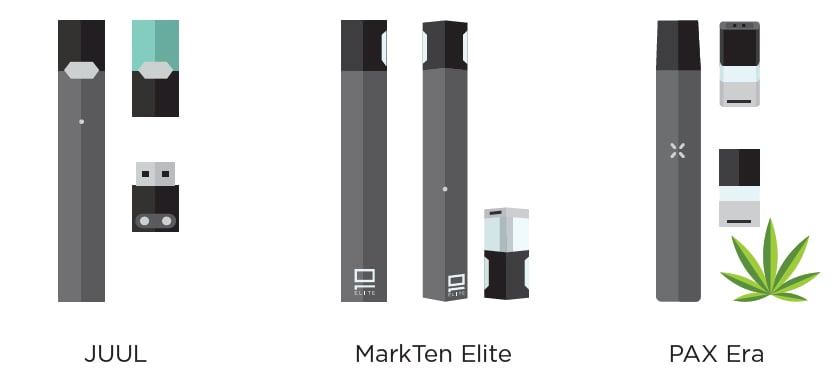E-cigarettes remain the most commonly used tobacco product among U.S. youth. In 2024, about 5.9% of middle and high school students reported vaping in the previous 30 days (Centers for Disease Control and Prevention [CDC], 2024a).
Vaping is not a harmless alternative. Most e-cigarettes contain nicotine, a highly addictive substance known to affect adolescent brain development, including attention, learning, and impulse control (CDC, 2023).
Vaping is also associated with increased anxiety, mood changes, and sleep disruption among teens (WellSpring Prevention, 2024).
Given the health risks and continued prevalence of vaping, prevention remains a critical public health priority.
Preventing teen vaping requires coordinated efforts. Parents, educators, health care professionals, and community leaders all contribute to creating prevention-focused environments (CDC, 2023). With this shared responsibility in mind, several strategies have been shown to significantly reduce youth vaping.
Evidence-Backed Prevention and Intervention
Interventions that combine individual and personalized education, school-based programming, and community policy tend to have the strongest measurable effect on reducing youth vaping (BMJ Open, 2025).
Key Strategies to Implement
• Raise awareness with accurate, age-appropriate information
Many teens underestimate the risks of vaping. Explaining how e-cigarettes work and the chemicals they contain helps build informed decision-making (CDC, 2023).
• Limit exposure to marketing and flavored products
Flavored e-cigarettes are disproportionately used by youth and often contribute to initiation (FDA & CDC, 2024).
Regulating online advertising and enforcing age verification can reduce access and exposure (CDC, 2023).
• Provide coping skills training and healthy alternatives
Stress, social pressure, and emotional struggles are among the most common reasons teens start vaping. Teaching healthy coping skills reduces vulnerability (WellSpring Prevention, 2024).
• Offer support and quitting resources without shame
Many teens who vape want to quit. Screening, counseling, and access to youth-friendly cessation support are key (Substance Abuse and Mental Health Services Administration [SAMHSA], 2020; JAMA Network, 2024).
• Implement school and community prevention programs
School-based education and community coalitions have consistent positive effects when combined with policy efforts (SAMHSA, 2020; BMJ Open, 2025).
• Encourage positive role modeling by adults
Adolescents often imitate adult behaviors, making positive role modeling an important part of prevention (CDC, 2023).
Understand “Hidden” E-Cigarettes
Teens may hide e-cigarettes in plain sight, and adults may see them without realizing what they are. Certain devices, such as JUUL, resemble USB flash drives. A single JUUL pod contains as much nicotine as an entire pack of cigarettes. Other e-cigarettes are designed to look like highlighters, pens, or makeup products, making them easy to conceal.

How Different Groups Can Help
For Parents and Caregivers
-
Talk early and regularly about the risks of vaping (CDC, 2023).
-
Encourage healthy coping strategies and recreational activities.
-
Model healthy behaviors and maintain open dialogue.
For Schools and Educators
-
Implement evidence-based curriculum and peer-led programs (SAMHSA, 2020).
-
Focus on support and education rather than discipline.
-
Collaborate with families and community partners.
For Community Leaders and Policymakers
-
Enforce age verification laws (FDA & CDC, 2024).
-
Consider restrictions on flavored e-cigarette products.
-
Support funding for public health campaigns and school prevention programs.
For Teens
-
Learn the facts about vaping and nicotine’s effects on the brain (CDC, 2023).
-
Build stress-management and decision-making skills.
-
Seek help if you want to quit. You are not alone, and support is available (JAMA Network, 2024).
Administrators should consider partnering with 3rd Mil because our Nicotine 101 course provides an evidence-based, non-punitive intervention that supports student well-being while reducing repeat incidents. The program equips students with practical coping skills, accurate information about nicotine, and personalized strategies for change, which leads to better outcomes than traditional disciplinary approaches. By using a research-informed, student-centered intervention, schools can address vaping behavior more effectively and strengthen their overall prevention efforts.
References
BMJ Open. (2025). Comprehensive, multi-level interventions to reduce youth vaping: A systematic review. BMJ Open, 15(1), Article e092380. https://bmjopen.bmj.com/content/15/1/e092380
Centers for Disease Control and Prevention. (2023). Electronic cigarettes: What parents need to know. https://www.cdc.gov/tobacco/basic_information/e-cigarettes/pdfs/OSH-E-Cigarettes-and-Youth-What-Parents-Need-to-Know-508.pdf
Centers for Disease Control and Prevention. (2024a). Electronic cigarette use among middle and high school students: United States, 2024 (Data Brief No. 524). https://www.cdc.gov/nchs/products/databriefs/db524.htm
Food and Drug Administration & Centers for Disease Control and Prevention. (2024). Results from the annual National Youth Tobacco Survey. https://www.fda.gov/tobacco-products/youth-and-tobacco/results-annual-national-youth-tobacco-survey
JAMA Network. (2024). Youth e-cigarette use, screening, and cessation supports: Clinical considerations. https://jamanetwork.com/journals/jama/fullarticle/2822166
Substance Abuse and Mental Health Services Administration. (2020). Reducing vaping among youth and young adults. https://www.samhsa.gov/resource/ebp/reducing-vaping-among-youth-young-adults
WellSpring Prevention. (2024). Teen nicotine vaping and health effects. https://wellspringprevention.org/blog/teen-nicotine-vaping-health-effects/




